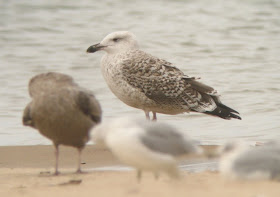One of the young greater black-backeds that's been hanging out. I was confused on the age at the time since it seems like these same birds have been around for over a year but it has a virtually all dark bill. Review of Howell and Dunn shows that greater black-backeds don't get the bi-colored bill so typical of 2nd cycle herrings; this bird is a typical 2nd cycle great black-backed.

I've been able to visit the lake more frequently after dropping Hazel off to pre-school in the mornings. Semi-palmated sandpipers were pretty common in mid-September (young ones at least). There is some variability in the bare parts colors, the first bird has brighter legs and eyering than the second bird. (Just for the sake of the exercise, per Karlson, common ringed plover also has a duller eyering, however the face mask is of more even width so more dark in the lores and more narrow through the cheek than a semi plover).



Finally, the title of the blog. Back when Ginger and I were dating and in the BC (before children) days, we might enjoy an occasional glass of wine. There are many foofoo books about how to become a proper wine connoisseur; I chose vintages with a bird on the label.
 Alas, the collection made way on the shelf for a binder with Hazel's rapidly amassing pre-school works of art. I told Ginger I was finally ready to part with it, I think the bottles were smashing in the trash can before I finished the sentence. Personally I'm surprised they survived the move. I never did figure out if the hummingbird was white-eared or Xantus's, either way an interesting choice for a California grower. White-eared was my ABA bird #500. The Traverse City cherry wine very appropriately displays a robin. The central bottle is something called Smoking Loon. The cork was lettered "woo-aah-ah-ah, woo-ah, cough cough, woo-ah, woo-ah-ah," or something to that effect. If ever I host a birder's potluck (which was done semi-regularly by various people back in the Washtenaw days), you'll know what to expect from the drinks table...
Alas, the collection made way on the shelf for a binder with Hazel's rapidly amassing pre-school works of art. I told Ginger I was finally ready to part with it, I think the bottles were smashing in the trash can before I finished the sentence. Personally I'm surprised they survived the move. I never did figure out if the hummingbird was white-eared or Xantus's, either way an interesting choice for a California grower. White-eared was my ABA bird #500. The Traverse City cherry wine very appropriately displays a robin. The central bottle is something called Smoking Loon. The cork was lettered "woo-aah-ah-ah, woo-ah, cough cough, woo-ah, woo-ah-ah," or something to that effect. If ever I host a birder's potluck (which was done semi-regularly by various people back in the Washtenaw days), you'll know what to expect from the drinks table...
No comments:
Post a Comment